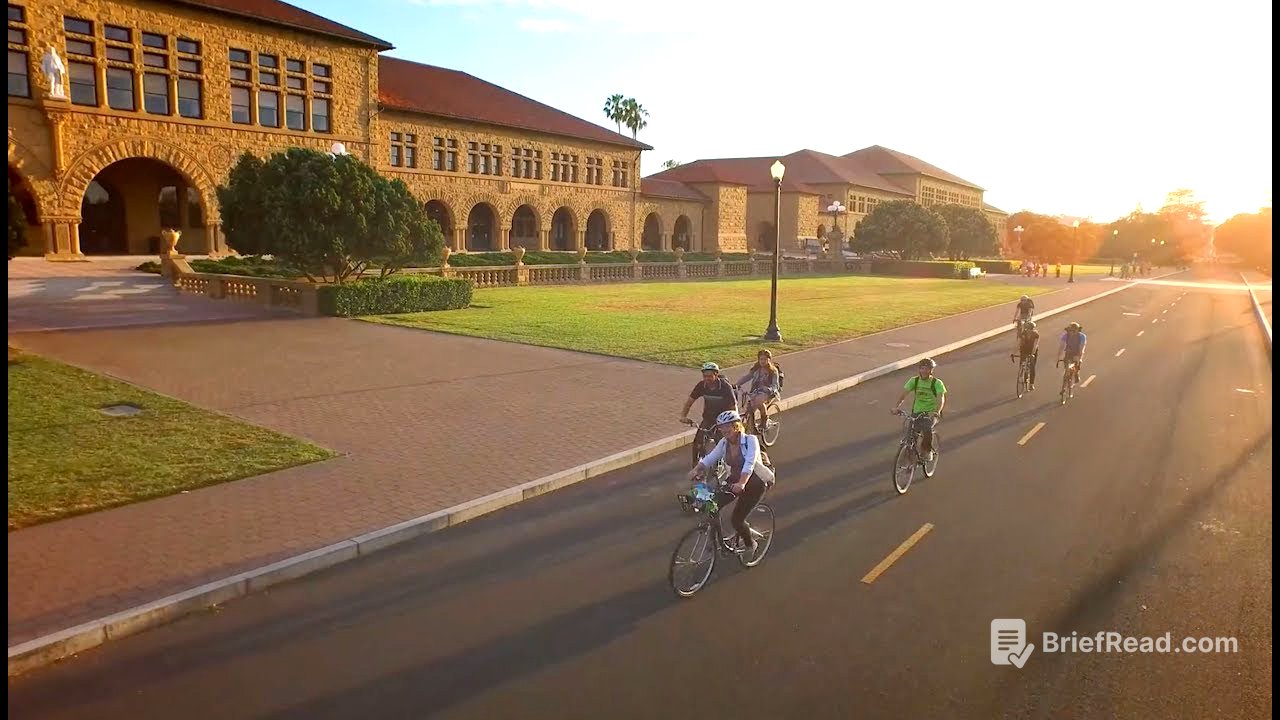TLDR;
This "Discover Stanford" information session provides an overview of Stanford University, covering academic freedom, diversity, campus culture, the application process, and financial aid. It emphasises the flexibility of the quarter system, the importance of interdisciplinary work, and the diverse community. The admission process is holistic, considering both quantitative and qualitative aspects, with a need-based financial aid program designed to make Stanford accessible to all admitted students.
- Stanford's quarter system allows students to take more classes and explore various interests.
- The admission process is holistic, focusing on academic excellence and diverse perspectives.
- Financial aid is need-based, with no loans included in the packages, ensuring accessibility for admitted students.
Introduction [0:01]
Kevin introduces the pre-recorded "Discover Stanford" virtual information session, designed for those unable to attend live programs. Attendees are encouraged to take notes but are prohibited from recording the session due to copyrighted material. The session will focus on life at Stanford in a typical year, with COVID-19 related information available on the university's health alerts website.
Student and Admission Officer Introductions [0:49]
Chase, a junior from Seattle studying International Relations, discusses his involvement in StanfordVotes, the Jazz Orchestra, and intramural sports. Jess, a senior from London, highlights her participation in female-oriented student groups and entrepreneurship organisations. Amber Lewis, an admission officer and former Stanford student, manages the International Ambassador program. Philip Lotze, another admission officer, shares his experience in reading domestic and international applications and his background as a high school counsellor.
Key Aspects of Stanford [2:25]
Chase and Jess introduce Stanford, acknowledging its location on the ancestral land of the Muwekma Ohlone Tribe and emphasising the university's commitment to honouring Native peoples. Stanford is located in Northern California, in Silicon Valley, near San Francisco and San Jose, with the Sierra Nevada mountains to the east and the Pacific Ocean to the west. The key contributors to the Stanford experience are academic freedom, diversity, and campus culture.
Academic Freedom and the Quarter System [3:27]
Stanford's motto, "The wind of freedom blows," shapes the academic experience, encouraging students to create their own path. The quarter system, with four academic terms each year, allows students to take 50% more classes than on a semester-based system. Students are admitted to Stanford as a whole and are not expected to declare a major until the end of their sophomore year. They can graduate with two majors, a major and a minor, with honours, or with a co-terminal degree, which allows them to work toward a master's degree while completing their bachelor's.
Interdisciplinary Opportunities and Experiential Learning [5:51]
The quarter system allows students to try new things and connect with professors through small classes like introductory seminars (intro-sems). Stanford emphasises interdisciplinary work, with many majors spanning multiple departments. Students can explore interests outside their major, such as visual and performing arts or STEM fields. Experiential learning opportunities include Stanford-operated study abroad programs, the Stanford Diversity Exchange with historically black colleges and universities, and funding for student research in any discipline.
Diversity and Community at Stanford [10:05]
Stanford has been coeducational since its founding and is open to all people, supporting students regardless of socioeconomic status. The student body includes individuals from over 70 countries and all 50 U.S. states, with 19% of the first-year class being first-generation college students and 12% being international students. Diversity is broadly defined, encompassing racial and ethnic diversity, socioeconomic status, and various life experiences.
Community Centres and Athletics [11:52]
Stanford has seven community centres that provide physical spaces and programming for students to explore their identities and learn about others' experiences. These centres are dedicated to Asian American, Black, LatinX, Queer, Muslim, Native American students, and all women on campus. Stanford's community spirit is also fostered through athletics, with 25 Division I teams, over 30 club teams, and various intramural teams. Students have access to extensive athletic facilities and free admission to regular season competitions.
Residential Life and Public Service [14:41]
Stanford is highly residential, with housing guaranteed for all four years. There are various housing options, including all-freshman dorms, four-class dorms, and themed houses. The Haas Center for Public Service provides resources for students to engage in service within the Bay Area community, offering full-time service opportunities and career advising for public sector jobs. BEAM (Bridging Education, Ambition, and Meaningful Work) helps students connect their learning to a career.
Alumni Network and Unique Aspects of Stanford [17:17]
Stanford has a global alumni network of over 220,000 who support current students through mentoring, internships, and hiring. The university fosters a collaborative culture where students take their work seriously but don't take themselves too seriously. The strong sense of community and the diverse perspectives of peers contribute to personal and professional growth.
Introduction to Admission Process [19:50]
Amber and Philip, admission officers, introduce the admission process, aiming to explain the requirements and their purpose. The goal is to help applicants understand how to use the application components to tell their story. Stanford focuses on building a class with diverse perspectives and academic excellence is the most important standard.
Holistic Admission and Quantitative Components [21:43]
Stanford practices holistic admission, where each application piece is important and reviewed alongside others, without GPA or test score cut-offs. The review considers each applicant's unique context and opportunities. The quantitative parts of the application, including transcripts, school reports, and testing, are an important starting point.
Transcripts and Academic Rigour [23:17]
The academic record is the cornerstone of the application, showing the classes taken and performance in them. While there is no GPA requirement, the transcript is carefully reviewed. A robust course load throughout high school is expected, including core liberal arts and science areas. The rigour of the curriculum demonstrates preparedness for a Stanford education.
School Report and Standardised Tests [26:21]
The school report provides contextual information about the high school, including its grading system and curriculum. For the 2020-2021 application cycle, Stanford will not require any testing, with no penalty for not submitting scores. In a typical year, standardised tests provide a universal measure of applicants within the larger pool.
Qualitative Components: Extracurriculars and Essays [29:17]
The qualitative portion allows candidates to distinguish themselves, revealing the person behind the application. The extracurricular chart shares how applicants spend their time, valuing depth of commitment over quantity. Essays, including the personal essay and the Stanford supplement, provide a direct voice to the admission committee, showcasing interests and personality.
Letters of Recommendation and Alumni Interviews [32:12]
Letters of recommendation from two teachers and a school official provide insights into the applicant's character and abilities. Teacher recommendations should come from those who know the applicant well and can speak to their intellectual abilities. An optional alumni interview may be offered, providing added perspective on the application.
Application Options and Deadlines [34:53]
Students apply online using either the Coalition Application or Common Application, with no preference between the two. There are two application schedules: Regular Decision (RD) and Restrictive Early Action (REA). REA is for students who know Stanford is their first choice, but there is no strategic advantage to applying in REA versus RD. Transfer applications are due by March 15 each year.
Authenticity and Final Thoughts on Admission [37:47]
Authenticity is key throughout the application process. Applicants should focus on their interests and passions, bringing that enthusiasm to Stanford. The admission committee appreciates the hard work and considers it a privilege to get to know each applicant.
Introduction to Financial Aid [39:12]
Stanford is committed to providing a comprehensive financial aid program that makes the Stanford experience possible for all admitted students. The program is entirely need-based, with aid offered to those who need it. Stanford is need-blind in its admission process for U.S. citizens, permanent residents, and undocumented students.
Financial Aid Application and Benchmarks [40:33]
To apply for financial aid, U.S. citizens and eligible non-citizens must submit the FAFSA and the CSS Profile. International citizens only need to complete the CSS Profile. For families with annual incomes less than $150,000, aid covers at least the cost of tuition. For those with incomes less than $75,000, there is no expected parent contribution. Financial aid packages are tailored to each family's specific financial situation.
Conclusion and Additional Resources [42:53]
The session concludes by encouraging prospective applicants to explore the admission and financial aid websites and social media accounts for more information. The speakers express their hope that the session has been helpful and wish the applicants well in their academic journey. Viewers are directed to an immersive 360° guided tour available on the admission website.









